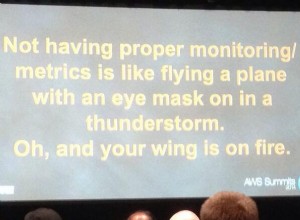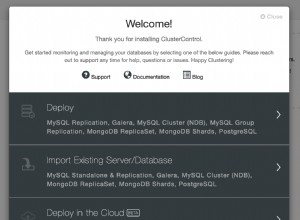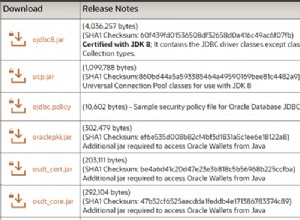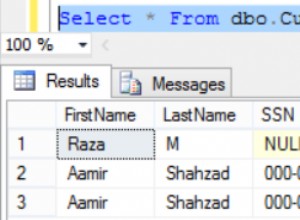La cause typique d'une application qui utilise SQLite et qui copie une base de données préexistante qui ne fonctionne soudainement pas pour l'API 28 est de contourner le problème de la base de données dossier non existant (la copie échouerait si le répertoire n'existait pas) consiste à créer une base de données vide, puis à écraser la base de données.
Cependant, comme par défaut, à partir de l'API 28, le SDK utilise WAL (Write-ahead logging) et que la création de la base de données vide à écraser entraîne la création des fichiers -shm et -wal. C'est l'existence de ces fichiers qui fait que la base de données est vide après la copie.
- Je pense que c'est parce qu'une fois la base de données copiée ouverte, une incohérence est détectée et les méthodes du SDK créent une base de données utilisable vide (ce n'est qu'une conjecture et cela n'a pas été démontré).
Solution rapide
La solution rapide, mais non recommandée, consiste à remplacer le onConfigure méthode dans la classe qui sous-classe SQLiteOpenHelper pour utiliser le disableWriteAheadLogging pour que la base de données soit ouverte en mode journal.
- le code complet ci-dessous (2e morceau de code) l'inclut, mais la ligne a été commentée.
Correction recommandée
La méthode recommandée, afin de bénéficier des avantages de WAL, est de vérifier l'existence du répertoire de la base de données et de créer le répertoire s'il n'existe pas plutôt que de créer une base de données à écraser (et donc le - Les fichiers shm et -wal n'existent pas lorsque la base de données est copiée )
Ce qui suit est un exemple de méthode où le répertoire est vérifié/créé lors de la vérification pour voir si la base de données existe (évidemment, cela devrait être adapté en conséquence ) :-
private boolean checkDataBase() {
/**
* Does not open the database instead checks to see if the file exists
* also creates the databases directory if it does not exists
* (the real reason why the database is opened, which appears to result in issues)
*/
File db = new File(myContext.getDatabasePath(DB_NAME).getPath()); //Get the file name of the database
if (db.exists()) return true; // If it exists then return doing nothing
// Get the parent (directory in which the database file would be)
File dbdir = db.getParentFile();
// If the directory does not exits then make the directory (and higher level directories)
if (!dbdir.exists()) {
db.getParentFile().mkdirs();
dbdir.mkdirs();
}
return false;
}
- Notez que cela repose sur la variable DB_NAME étant le nom de la base de données (nom de fichier du fichier de base de données) et que l'emplacement final de la base de données est l'emplacement standard (data/data/the_package/databases/).
Ce qui précède a été extrait de la sous-classe suivante de SQLiteOpenHelper :-
public class DBHelper extends SQLiteOpenHelper {
private static String DB_NAME = "db";
private SQLiteDatabase myDataBase;
private final Context myContext;
private int bytes_copied = 0;
private static int buffer_size = 1024;
private int blocks_copied = 0;
public DBHelper(Context context) {
super(context, DB_NAME, null, 1);
this.myContext = context;
// Check for and create (copy DB from assets) when constructing the DBHelper
if (!checkDataBase()) {
bytes_copied = 0;
blocks_copied = 0;
createDataBase();
}
}
/**
* Creates an empty database on the system and rewrites it with your own database.
* */
public void createDataBase() {
boolean dbExist = checkDataBase(); // Double check
if(dbExist){
//do nothing - database already exists
} else {
//By calling this method an empty database will be created into the default system path
//of your application so we are gonna be able to overwrite that database with our database.
//this.getReadableDatabase();
//<<<<<<<<<< Dimsiss the above comment
//By calling this method an empty database IS NOT created nor are the related -shm and -wal files
//The method that creates the database is flawed and was only used to resolve the issue
//of the copy failing in the absence of the databases directory.
//The dbExist method, now utilised, checks for and creates the database directory, so there
//is then no need to create the database just to create the databases library. As a result
//the -shm and -wal files will not exist and thus result in the error associated with
//Android 9+ failing with due to tables not existining after an apparently successful
//copy.
try {
copyDataBase();
} catch (IOException e) {
File db = new File(myContext.getDatabasePath(DB_NAME).getPath());
if (db.exists()) {
db.delete();
}
e.printStackTrace();
throw new RuntimeException("Error copying database (see stack-trace above)");
}
}
}
/**
* Check if the database already exist to avoid re-copying the file each time you open the application.
* @return true if it exists, false if it doesn't
*/
private boolean checkDataBase() {
/**
* Does not open the database instead checks to see if the file exists
* also creates the databases directory if it does not exists
* (the real reason why the database is opened, which appears to result in issues)
*/
File db = new File(myContext.getDatabasePath(DB_NAME).getPath()); //Get the file name of the database
Log.d("DBPATH","DB Path is " + db.getPath()); //TODO remove for Live App
if (db.exists()) return true; // If it exists then return doing nothing
// Get the parent (directory in which the database file would be)
File dbdir = db.getParentFile();
// If the directory does not exits then make the directory (and higher level directories)
if (!dbdir.exists()) {
db.getParentFile().mkdirs();
dbdir.mkdirs();
}
return false;
}
/**
* Copies your database from your local assets-folder to the just created empty database in the
* system folder, from where it can be accessed and handled.
* This is done by transfering bytestream.
* */
private void copyDataBase() throws IOException {
final String TAG = "COPYDATABASE";
//Open your local db as the input stream
Log.d(TAG,"Initiated Copy of the database file " + DB_NAME + " from the assets folder."); //TODO remove for Live App
InputStream myInput = myContext.getAssets().open(DB_NAME); // Open the Asset file
String dbpath = myContext.getDatabasePath(DB_NAME).getPath();
Log.d(TAG,"Asset file " + DB_NAME + " found so attmepting to copy to " + dbpath); //TODO remove for Live App
// Path to the just created empty db
//String outFileName = DB_PATH + DB_NAME;
//Open the empty db as the output stream
File outfile = new File(myContext.getDatabasePath(DB_NAME).toString());
Log.d("DBPATH","path is " + outfile.getPath()); //TODO remove for Live App
//outfile.setWritable(true); // NOT NEEDED as permission already applies
//OutputStream myoutputx2 = new FileOutputStream(outfile);
/* Note done in checkDatabase method
if (!outfile.getParentFile().exists()) {
outfile.getParentFile().mkdirs();
}
*/
OutputStream myOutput = new FileOutputStream(outfile);
//transfer bytes from the inputfile to the outputfile
byte[] buffer = new byte[buffer_size];
int length;
while ((length = myInput.read(buffer))>0) {
blocks_copied++;
Log.d(TAG,"Ateempting copy of block " + String.valueOf(blocks_copied) + " which has " + String.valueOf(length) + " bytes."); //TODO remove for Live App
myOutput.write(buffer, 0, length);
bytes_copied += length;
}
Log.d(TAG,
"Finished copying Database " + DB_NAME +
" from the assets folder, to " + dbpath +
String.valueOf(bytes_copied) + "were copied, in " +
String.valueOf(blocks_copied) + " blocks of size " +
String.valueOf(buffer_size) + "."
); //TODO remove for Live App
//Close the streams
myOutput.flush();
myOutput.close();
myInput.close();
Log.d(TAG,"All Streams have been flushed and closed."); //TODO remove for Live App
}
@Override
public synchronized void close() {
if(myDataBase != null)
myDataBase.close();
super.close();
}
@Override
public void onCreate(SQLiteDatabase db) {
}
@Override
public void onUpgrade(SQLiteDatabase db, int oldVersion, int newVersion) {
}
@Override
public void onConfigure(SQLiteDatabase db) {
super.onConfigure(db);
Log.d("DBCONFIGURE","Database has been configured "); //TODO remove for Live App
//db.disableWriteAheadLogging(); //<<<<<<<<<< un-comment to force journal mode
}
@Override
public void onOpen(SQLiteDatabase db) {
super.onOpen(db);
Log.d("DBOPENED","Database has been opened."); //TODO remove for live App
}
}
- Notez que le code ci-dessus est/était destiné au développement/à l'expérimentation et inclut donc du code qui pourrait être supprimé.




